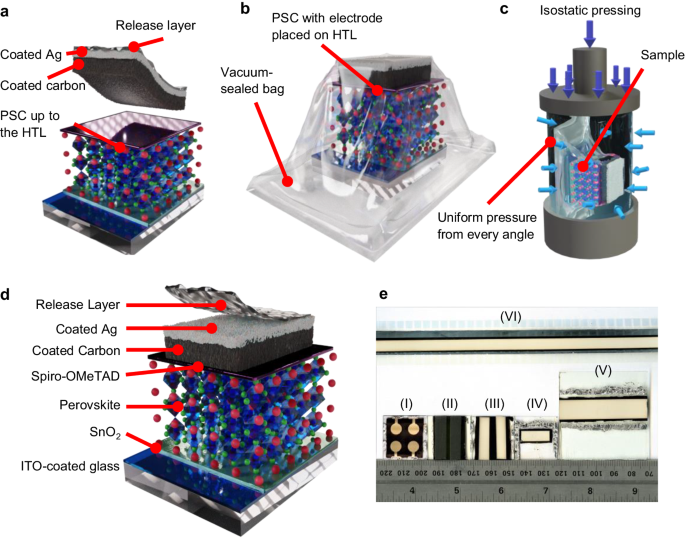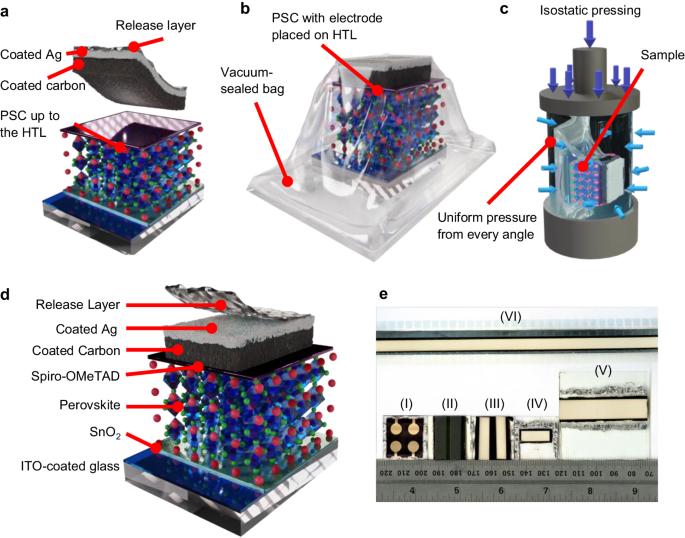制造多功能碳电极型过氧化物太阳能电池的高压等静压层压技术
IF 7.5
Q1 MATERIALS SCIENCE, MULTIDISCIPLINARY
引用次数: 0
摘要
采用蒸发金(Au)电极的过氧化物太阳能电池(PSCs)已显示出极高的效率,但该技术的成熟需要低成本和可扩展的替代品,以推进其商业化进程。基于碳电极的 PSC(C-PSC)是一种前景广阔的替代方案,然而,如何在不损坏底层功能层的情况下优化空穴传输层(HTL)与碳电极之间的界面是一项长期的挑战。在此,我们介绍了一种使用等静压机的层压技术,该技术可以施加超高压,在不损坏器件的情况下物理形成与真空蒸发电极相同的 HTL/碳界面。研究级 C-PSC 的功率转换效率(PCE)高达 20.8%,而大面积 C-PSC 的功率转换效率(PCE)分别为 19.8% 和 16.9%,电池面积分别为 0.95 平方厘米和 5.5 平方厘米。在加速操作稳定性测试(ISOS-L-1)中,未封装的 C-PSC 明显优于金电极器件,1000 小时后仍能保持 84% 的初始 PCE。本文章由计算机程序翻译,如有差异,请以英文原文为准。


A high-pressure isostatic lamination technique to fabricate versatile carbon electrode-based perovskite solar cells
Perovskite solar cells (PSCs) with evaporated gold (Au) electrodes have shown great efficiencies, but the maturity of the technology demands low-cost and scalable alternatives to progress towards commercialisation. Carbon electrode-based PSCs (C-PSCs) represent a promising alternative, however, optimising the interface between the hole transport layer (HTL) and the carbon electrode without damaging the underlying functional layers is a persistent challenge. Here, we describe a lamination technique using an isostatic press that can apply exceedingly high pressure to physically form an HTL/carbon interface on par with vacuum-evaporated electrodes, without damaging the device. Research-scale C-PSCs with a power conversion efficiency (PCE) of up to 20.8% are demonstrated along with large-area C-PSCs with PCEs of 19.8% and 16.9% for cell areas of 0.95 cm2 and 5.5 cm2, respectively. The unencapsulated C-PSCs significantly outperform the Au-electrode devices in accelerated operational stability testing (ISOS-L-1), retaining 84% of the initial PCE after 1000 h. Additionally, this versatile technique is also used to fabricate flexible, roll-to-roll printed C-PSCs with efficiencies of up to 15.8%. Carbon electrode-based perovskite solar cells require a high-quality interface between the hole transport layer and the electrode. Here, lamination using an isostatic press is used to form this interface, achieving a power conversion efficiency of 16.9% for a 5.5 cm2 area device.
求助全文
通过发布文献求助,成功后即可免费获取论文全文。
去求助
来源期刊

Communications Materials
MATERIALS SCIENCE, MULTIDISCIPLINARY-
CiteScore
12.10
自引率
1.30%
发文量
85
审稿时长
17 weeks
期刊介绍:
Communications Materials, a selective open access journal within Nature Portfolio, is dedicated to publishing top-tier research, reviews, and commentary across all facets of materials science. The journal showcases significant advancements in specialized research areas, encompassing both fundamental and applied studies. Serving as an open access option for materials sciences, Communications Materials applies less stringent criteria for impact and significance compared to Nature-branded journals, including Nature Communications.
 求助内容:
求助内容: 应助结果提醒方式:
应助结果提醒方式:


